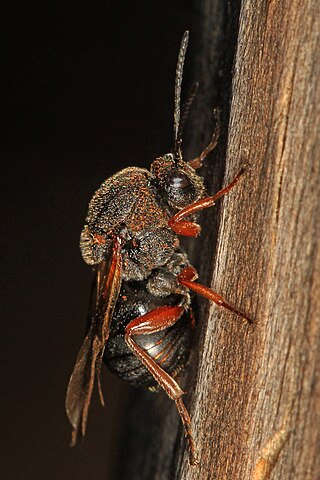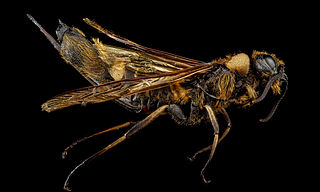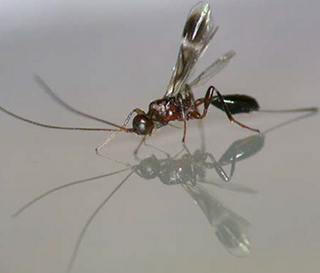
In evolutionary ecology, a parasitoid is an organism that lives in close association with its host at the host's expense, eventually resulting in the death of the host. Parasitoidism is one of six major evolutionary strategies within parasitism, distinguished by the fatal prognosis for the host, which makes the strategy close to predation.

The Tachinidae are a large and variable family of true flies within the insect order Diptera, with more than 8,200 known species and many more to be discovered. Over 1,300 species have been described in North America alone. Insects in this family commonly are called tachinid flies or simply tachinids. As far as is known, they all are protelean parasitoids, or occasionally parasites, of arthropods, usually other insects. The family is known from many habitats in all zoogeographical regions and is especially diverse in South America.

Sawflies are the insects of the suborder Symphyta within the order Hymenoptera, alongside ants, bees, and wasps. The common name comes from the saw-like appearance of the ovipositor, which the females use to cut into the plants where they lay their eggs. The name is associated especially with the Tenthredinoidea, by far the largest superfamily in the suborder, with about 7,000 known species; in the entire suborder, there are 8,000 described species in more than 800 genera. Symphyta is paraphyletic, consisting of several basal groups within the order Hymenoptera, each one rooted inside the previous group, ending with the Apocrita which are not sawflies.

Diplolepis is a genus of approximately fifty species in the gall wasp family Cynipidae. The larvae induce galls on wild roses (Rosa), and rarely on domestic roses.

Gall wasps, also traditionally calledgallflies, are hymenopterans of the family Cynipidae in the wasp superfamily Cynipoidea. Their common name comes from the galls they induce on plants for larval development. About 1,300 species of this generally very small creature are known worldwide, with about 360 species of 36 different genera in Europe and some 800 species in North America.

Horntail or wood wasp are any of the 150 non-social species of the hymenopteran family Siricidae, a type of wood-eating sawfly. The common name "horntail" derives from the stout, spine-like structure at the end of the adult's abdomen, which is used to pierce the host's bark to allow the eggs to be inserted into the wood. A typical adult horntail is brown, blue, or black with yellow or red parts, and may often reach up to 4 cm (1.6 in) long. The pigeon horntail can grow up to 5 cm (2.0 in) long, among the longest of all Hymenoptera.

Parasitoid wasps are a large group of hymenopteran superfamilies, with all but the wood wasps (Orussoidea) being in the wasp-waisted Apocrita. As parasitoids, they lay their eggs on or in the bodies of other arthropods, sooner or later causing the death of these hosts. Different species specialise in hosts from different insect orders, most often Lepidoptera, though some select beetles, flies, or bugs; the spider wasps (Pompilidae) exclusively attack spiders. More rarely, parasitoid wasps may use plant seeds as hosts, such as Torymus druparum.

The Orussidae or the parasitic wood wasps represent a small family of sawflies ("Symphyta"). Currently, about 93 extant and four fossil species are known. They take a key position in phylogenetic analyses of Hymenoptera, because they form the sister taxon of the megadiverse apocritan wasps, and the common ancestor of Orussidae + Apocrita evolved parasitism for the first time in course of the evolution of the Hymenoptera. They are also the only sawflies with carnivorous larvae.

Megalyroidea is a small hymenopteran superfamily of wasps that includes a single family, Megalyridae, with eight extant genera and 49 described species. Modern megalyrids are found primarily in the southern hemisphere, though fossils have only been found in the northern hemisphere. The most abundant and species-rich megalyrid fauna is in Australia. Another peak of diversity appears to be in the relict forests of Madagascar, but most of these species are still undescribed.

Cotesia congregata is a parasitoid wasp of the genus Cotesia. The genus is particularly noted for its use of polydnaviruses. Parasitoids are distinct from true parasites in that a parasitoid will ultimately kill its host or otherwise sterilize it.
Maacynips papuana is a species of gall wasp tentatively placed in the tribe Eucoilini. It was first described in 1963 by Carl M. Yoshimoto. Maacynips as a genus was placed under the tribe Eucoilini in 2008 by Forshage, Nordlander, and Ronquist. The genus is currently under review and its status, along with that of its member species, is unclear.

Rhyssa persuasoria, also known as the sabre wasp, is a species belonging to the family Ichneumonidae subfamily Rhyssinae. Members of this subfamily, including those of Rhyssa and the allied Megarhyssa, are also known collectively as giant ichneumonid wasps or giant ichneumons.

Spathius agrili is a parasitic non-stinging wasp of family Braconidae which is native to North Asia. It is a parasitoid of the emerald ash borer, an invasive species which has destroyed tens of millions of ash trees in its introduced range in North America. As part of the campaign against the emerald ash borer (EAB), American scientists in conjunction with the Chinese Academy of Forestry began searching in 2003 for its natural enemies in the wild, leading to the discovery of several parasitoid wasp species, including Spathius agrili. S. agrili was discovered in Tianjin, China where it is a prevalent parasitoid of EAB larvae in stands of an introduced ash species, and an endemic ash species. S. agrili has been recorded to attack and kill up to 90 percent of EAB larvae.

The sirex woodwasp is a species of horntail, native to Europe, Asia, and northern Africa. Adults vary in length from 9 to 36 mm.

Amylostereum is the single genus in the fungal family Amylostereaceae. The genus currently comprises four saprotrophic and parasitic species, which live off living or dead wood. The Amylostereaceae cause white rot in the wood by disintegrating the tissue component lignin. They produce crust-like, partially wavy fruit bodies on the surface of infested trees, which are similar to those produced by Stereum species.

Trogus is a genus of parasitoid wasp found in the Holarctic and Neotropic regions. It is placed in the subfamily Ichneumoninae and the tribe Ichneumonini. Trogus species are parasites of larvae and pupae of the swallowtail butterfly family, Papilionidae. The genus consists of twelve extant and one extinct species.
Maacynips is a genus of gall wasp tentatively placed in the tribe Eucoilini. It was originally described in 1963 by Carl M. Yoshimoto. Subsequent research did not find more samples of the genus. It was placed under the tribe Eucoilini in 2008 by Forshage, Nordlander, and Ronquist. Maacynips is currently under review and its status is unclear.

Ibalia leucospoides, the knife-shaped ibalia, is a species of ibaliid wasp in the family Ibaliidae.

Ibalia is a genus of ibaliid wasps in the family Ibaliidae. There are about 14 described species in Ibalia. All species are parasitoids of Siricidae species, which they seek out by detecting volatiles emitted by the fungi Siricidae larvae feed on, Amylostereum.
Urocerus japonicus, commonly known as the Japanese horntail, is a species of sawfly, native to southeastern Asia. Studies show that the dispersal distance of the female is higher than the male. The fungal species Amylostereum laevigatum had its first appearance in Japan via this sawfly.























